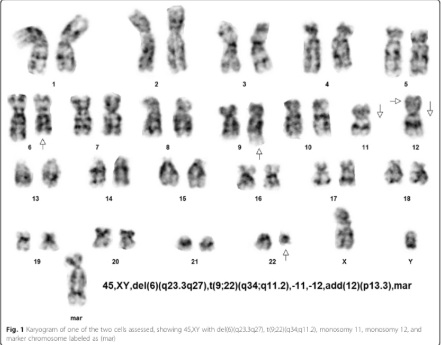
Contributions
Abstract: PB1535
Type: Publication Only
Session title: Chronic myeloid leukemia - Clinical
Background
BCR-ABL1, resulting from t(9;22), is the oncogenic driver of chronic myeloid leukemia and the therapeutic target of the disease. Molecular studies have been the gold standard modality for patient assessment since the advent of tyrosine kinase inhibitor therapy. In spite of that, there are cytogenetic abnormalities that can render the disease unresponsive to conventional therapy, thus making cytogenetics an important component of patient management guidelines.
Aims
To present a novel karyotype in CML with impact on clinical outcome of the patient.
Methods
Conventional Karyotyping using Giemsa Banding
Results
We present a case of a Tajik, Afghan patient with chronic myeloid leukemia with del(6)(q23.3q27), t(9;22)(q34;q11.2), monosomy 11, monosomy 12, and marker chromosome who, despite having typical clinical and hematological disease with initial response to therapy, progressed to blast crisis very early and thus required special interventions.

Conclusion
Cytogenetic monitoring is an important pillar in the management of patients with chronic myeloidleukemia that cannot be ignored. It should therefore be a part of patient management not only during diagnosisbut also during management. We present an unusual cytogenetic abnormality in a patient with chronic myeloidleukemia that resulted in early disease progression.
Keyword(s): Blast crisis, Chronic myeloid leukemia, Cytogenetic abnormalities
Abstract: PB1535
Type: Publication Only
Session title: Chronic myeloid leukemia - Clinical
Background
BCR-ABL1, resulting from t(9;22), is the oncogenic driver of chronic myeloid leukemia and the therapeutic target of the disease. Molecular studies have been the gold standard modality for patient assessment since the advent of tyrosine kinase inhibitor therapy. In spite of that, there are cytogenetic abnormalities that can render the disease unresponsive to conventional therapy, thus making cytogenetics an important component of patient management guidelines.
Aims
To present a novel karyotype in CML with impact on clinical outcome of the patient.
Methods
Conventional Karyotyping using Giemsa Banding
Results
We present a case of a Tajik, Afghan patient with chronic myeloid leukemia with del(6)(q23.3q27), t(9;22)(q34;q11.2), monosomy 11, monosomy 12, and marker chromosome who, despite having typical clinical and hematological disease with initial response to therapy, progressed to blast crisis very early and thus required special interventions.

Conclusion
Cytogenetic monitoring is an important pillar in the management of patients with chronic myeloidleukemia that cannot be ignored. It should therefore be a part of patient management not only during diagnosisbut also during management. We present an unusual cytogenetic abnormality in a patient with chronic myeloidleukemia that resulted in early disease progression.
Keyword(s): Blast crisis, Chronic myeloid leukemia, Cytogenetic abnormalities


